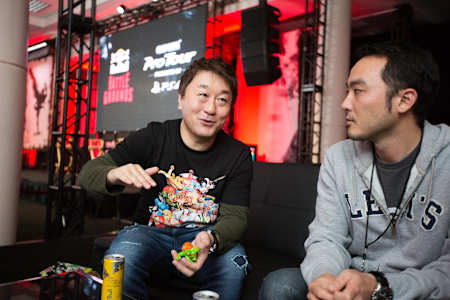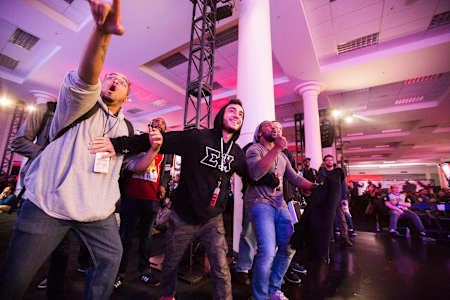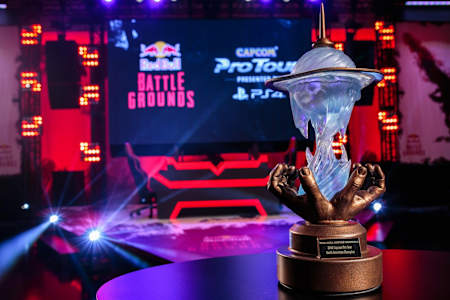Gaming
esports
Ono on the Evolving Street Fighter Scene
Yoshinori Ono discusses launch content for Street Fighter V and the evolution of Capcom's series.
SEATTLE — Yoshinori Ono is more than just the recent head of Street Fighter games; he's Capcom’s biggest public cheerleader for the franchise. Catching him, along with his signature Blanka figure, bouncing around events while cheering with fans is a common occurrence. Ono has more than just enthusiasm to share however. His long-rooted history with Capcom’s fighting franchises have helped shape the way forward through changing times.
Content concerns
"In terms of game modes, in the beginning we all know that we didn’t put out a complete product, in a way that is a learning experience," Ono saying in an interview at Red Bull Battle Grounds, acknowledging the rough start Street Fighter V endured earlier this year. "We try to progress forward and listen to the fans more, and see what they want and continue adding new modes and things to the game. What that content will be, we don’t know, but we’ll continue to get feedback from the users on what they are wanting."
Ono is humbled by the experience. "Way back when, it was difficult for me and Capcom to get feedback from users, especially from abroad, since the only way for us to get that would be to come here in person. Now, there are things like social media where I can get feedback from all over the world. That makes me very happy since Street Fighter is hitting the 30th anniversary next year, and that shows the evolution of fighting games."
"Being in an era where I can get that feedback is a very good time. The drawback to this is I also hear a lot of negative feedback," he laughs.
Evolving the Street Fighter scene
In its nearly 30-year history, Street Fighter competition has gone from dimly lit arcades to colossal stages broadcast to fans around the world.
The evolution of the Street Fighter competitive scene is not lost on Ono, who has been close to the franchise for nearly two decades. "I joined Capcom around Street Fighter II time, about 23 or 24 years ago, and I joined Capcom because I wanted to work on the Street Fighter games. Since then, there have been small tournaments in game centers in Japan and also in North America where they rent out small halls and things. In the past 10 years I’ve seen a lot of expansion in the competitive scene. I like coming here and seeing the players play, and also to get information that I can only get out of the competitive scene. I come to these events half for business, and half for pleasure."
Watching the players continue to grow along with these events is a great pleasure, and it has opened up how developers can learn about their game too. "I come to watch the players and see things so I think, 'Oh, maybe we can do these things or this for the players or spectators.' The players are the ones who have mastered SF, and the spectators have become accustomed to watching these events." Being approached by the different attendees with their own ideas is something inspiring, and Ono then takes these ideas back to Japan to share and expand on them. "Sometimes I also bring the dev team over so they can see and be inspired themselves."
Seeing large crowds of spectators enjoying tournaments contributed to the team wanting to introduce new ideas. "Up until SF4, we decided on an internal concept and just went out with that, and players enjoyed it. During SF4, the act of watching other people play became really popular. In SFV, we wanted to add battle mechanics that are really fun to watch. Of course, it’s still important for it to be balanced, for the actual players to enjoy it, and for them to be able to be aggressive. The main thing was to make it enjoyable to watch from spectators."
Even with the new level of increased scrutiny, balance issues still slip through the cracks. Techniques that seem like they may have been unintended are looking to be really strong right now. Many top players have pointed out specific ones as being problematic. Ono does a small hand motion to mimic Chun Li’s aerial Lightning Legs on the subject. "That kind of thing has been used all throughout Street Fighter’s history. In the original SF comboing wasn’t built in, but people figured out how to use it."
The history of fighting games is made up by a lot of player discovery like this, and it has been nurtured ever since. "When I watch and see something new I immediately ask, 'Is this going to be okay?' But then people will always figure out how to counter that, then people figure out how to counter that counter," explains Ono as he starts making stairs-like motions with his hands. “I feel like that is actually enjoyable; watching people figure out new techniques to counter the techniques that other people come up with. So that’s kind of a learning experience. If there is something uncounterable, then that’s where we think we might need to make a change.
Legacy and changing times
Ono builds up excitement as he explains the process of learning fighting games. "When the first Street Fighter came out, I was still a college student. During that time nobody knew how to do Hadoukens or Shoryukens," he says, acting out the franchise’s classic moves.
"We’d hear rumors that somebody at the local arcade was doing something crazy, so me and my friends would get on our bicycles," Ono explains as he does a speedy reenactment, "and pedal our way to the game center to check it out. Compared to now, that is about 10,000 times longer than it would take compared to somebody watching on Twitch."
This isn’t an exaggeration by any stretch. The way people are playing Street Fighter V after less than a year might have taken an actual decade to come about back then. Coping with those differences over the years is not an easy task for any developer. "I feel that time progresses whether I like it or not, so I try to look at it positively," Ono proclaims. "For instance, with CPT, people in Japan are able to watch in real time. So, if technology was taken away things would definitely be inconvenient now. Now we already have this technology, and since it’s so fast it’s more of a "what are we going to do now?" We try to adapt to that."
These aren’t the only changes to happen, as Street Fighter is now expected to live on through the competitive audience. "So yesterday, I had a talk with the director of our esports team while eating oysters," Ono tells us. "We’re thinking about the future of the tour too. CPT has been around for three years now, and if you compare that to a child, they wouldn’t even be in elementary school yet!" In a more level tone, he follows up with, "Over the next couple years, what we want to do is make sure the Capcom Pro Tour can stand alone on its own. We’re not quite there yet."
There is no shying away from the reality that Capcom Pro Tour is still very much a new concept for Capcom, and right now the company is still learning how to build and evolve it.
Ono, as he always seems to be, is optimistic. "Who knows though? We might have some news for you if you make it to Capcom Cup."






